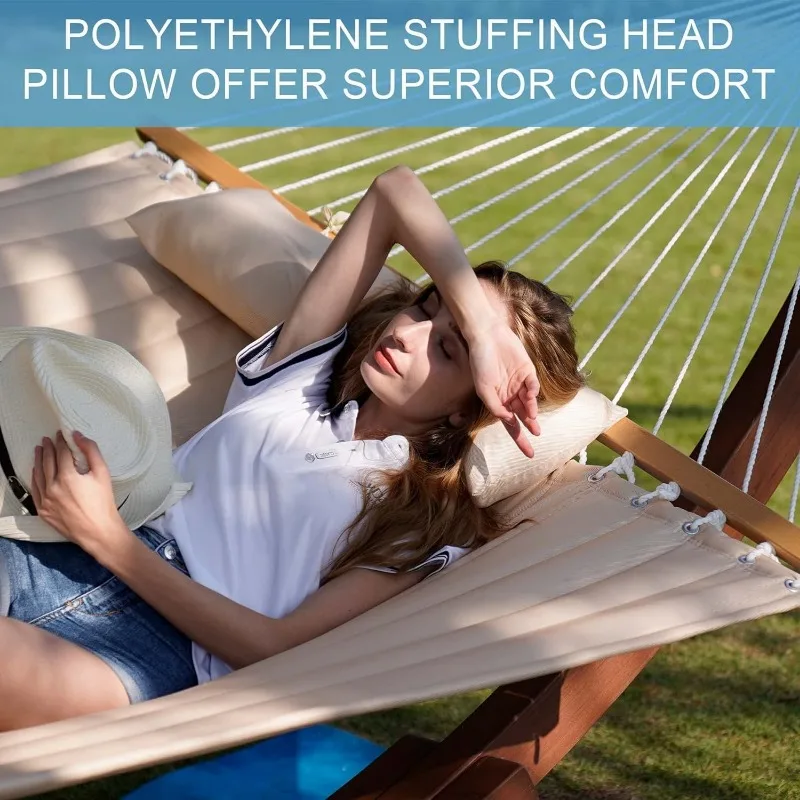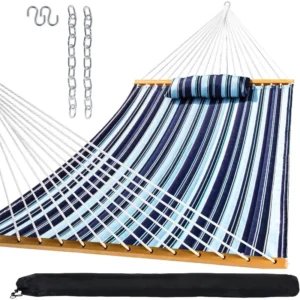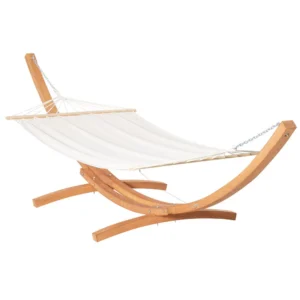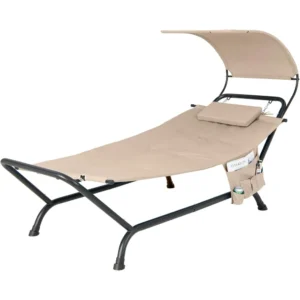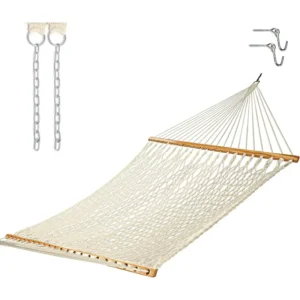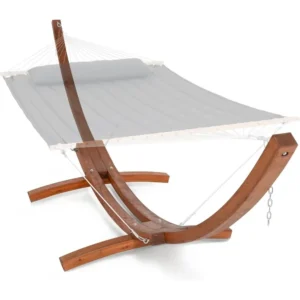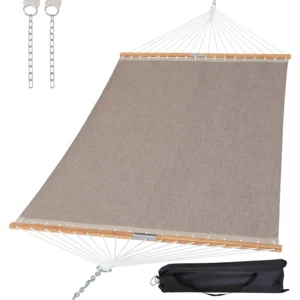What Makes a Quilted Hammock Truly “Cozy”?
When it comes to outdoor relaxation, few experiences match the enveloping comfort of a quilted hammock. But what exactly makes a hammock “cozy”? The secret lies in its unique construction – multiple layers of fabric with soft padding sandwiched between them, creating a cushioned sanctuary that cradles your body.
Unlike traditional rope or thin fabric hammocks, quilted versions offer a plush surface that eliminates pressure points and prevents the “banana effect” where your body sinks uncomfortably in the middle. The quilting process locks padding in place, creating a stable surface that distributes weight evenly across the entire hammock.
What truly sets quilted hammocks apart is the sensory experience they provide:
– A cushioned embrace that contours to your body
– Insulation that keeps you comfortable in varying temperatures
– Softness that feels luxurious against your skin
– Stability that allows for longer, more restful relaxation
This layered design creates a microclimate between you and the outside world, providing warmth when the air is cool and breathability when temperatures rise. The placement of your hammock in different environments can enhance this effect, making quilted options versatile for year-round enjoyment.
The fundamental difference between quilted and non-quilted hammocks is immediately apparent from the first moment you lie down – one offers basic suspension, while the other delivers a truly sumptuous relaxation experience.
Premium Fabric Materials: The Foundation of Comfort
The fabric covering your quilted hammock serves as both the first point of contact with your skin and the protective barrier against the elements. Premium materials make all the difference in creating that perfect cozy feeling.
Solution-Dyed Acrylics
High-end quilted hammocks often feature solution-dyed acrylic fabrics like Sunbrella®. These materials are created by adding color during the manufacturing process rather than after, resulting in colors that permeate the entire fiber. This provides exceptional fade resistance even after years of sun exposure. The fabric maintains its softness while offering outstanding durability against the elements.
DuraCord® and Enhanced Polyester
DuraCord® represents a significant advancement in outdoor fabrics, combining the softness of cotton with remarkable weather resistance. These materials resist fading, mold, mildew, and staining while maintaining a comfortable feel against the skin.
High-quality polyester options have also evolved tremendously, with technological improvements creating versions that feel surprisingly soft while offering excellent weather protection. Many premium quilted hammocks utilize enhanced polyester that dries quickly after morning dew or light rain.
Cotton and Cotton Blends
For indoor use or covered outdoor spaces, cotton and cotton blend fabrics provide unmatched softness and breathability. While requiring more protection from the elements, these natural materials create a luxurious tactile experience that synthetic options struggle to match.
The best fabric types for quilted hammocks balance several crucial factors: softness against skin, durability in different weather conditions, resistance to UV damage, and ease of cleaning. Premium hammocks often incorporate specialized treatments that enhance water repellency without compromising breathability, allowing you to enjoy your hammock soon after a light rain shower.
Quilting Design and Filling Material: The Heart of Coziness
The filling material and quilting pattern work together to create the plush comfort that defines a truly cozy hammock experience. This internal construction forms the literal and figurative “heart” of what makes quilted hammocks special.
Filling Materials
Premium quilted hammocks typically contain one of these high-quality fillings:
- Polyester fiberfill: The most common filling, offering excellent loft, reasonable moisture resistance, and good insulating properties. Higher grades provide better resilience and maintain their shape over time.
- Hollowfill fiber: An advanced form of polyester with hollow cores that trap air for superior insulation while remaining lightweight.
- Foam padding: Provides structured support and consistent thickness throughout the hammock, though less common than fiberfill options.
The density of the filling directly impacts both comfort and durability. Too sparse, and you’ll feel the outer layers pressing together; too dense, and the hammock becomes unnecessarily heavy and rigid.
Quilting Patterns
The stitching pattern does more than just secure filling in place – it fundamentally affects how the hammock contours to your body:
- Channel quilting: Creates parallel lines of stitching that allow for smooth weight distribution and easy body positioning
- Diamond quilting: Provides multi-directional flex and prevents filling from shifting to the sides
- Box quilting: Creates individual pockets of filling for consistent padding throughout
Quality stitching is crucial in preventing the filling from bunching or creating uncomfortable “cold spots” where padding has shifted away. Premium hammocks feature reinforced stitching at stress points and patterns designed to maintain even distribution of filling materials over years of use.
Seasonal considerations matter too – hammocks with denser filling provide better insulation during cooler weather, while more moderate filling allows for better airflow during warmer months. Our collection of quilted fabric hammock sets showcases various quilting designs to match different comfort preferences and seasons.
Spreader Bar Design: Balancing Stability and Comfort
Spreader bars dramatically influence both the feel and function of a quilted hammock. These horizontal rods at each end stretch the fabric flat, creating a more bed-like surface that’s easier to enter and exit.
The ideal spreader bar achieves a delicate balance – wide enough to create a stable, flat surface but not so rigid that the hammock can’t gently curve to cradle your body. The width of the bar directly affects how the hammock distributes weight and how likely you are to experience the dreaded “flip” that can occur with poorly designed hammocks.
Premium materials make a significant difference in spreader bar quality:
- Hardwoods like oak or cypress provide classic aesthetics and natural strength but require occasional maintenance to prevent weathering
- Composite materials offer excellent weather resistance without maintenance while maintaining necessary rigidity
- Marine-grade wood combines natural beauty with enhanced weather protection through specialized treatments
Safety considerations are paramount with spreader bars – they must securely attach to the hammock body while providing enough strength to support the rated weight capacity without flexing. Quality designs incorporate reinforced attachment points where the fabric meets the bar.
The overall comfort experience is notably influenced by spreader bar design, with proper width allowing you to lie diagonally across the hammock for maximum comfort. Our selection of spreader bar hammock sets features various designs optimized for stability and comfort.
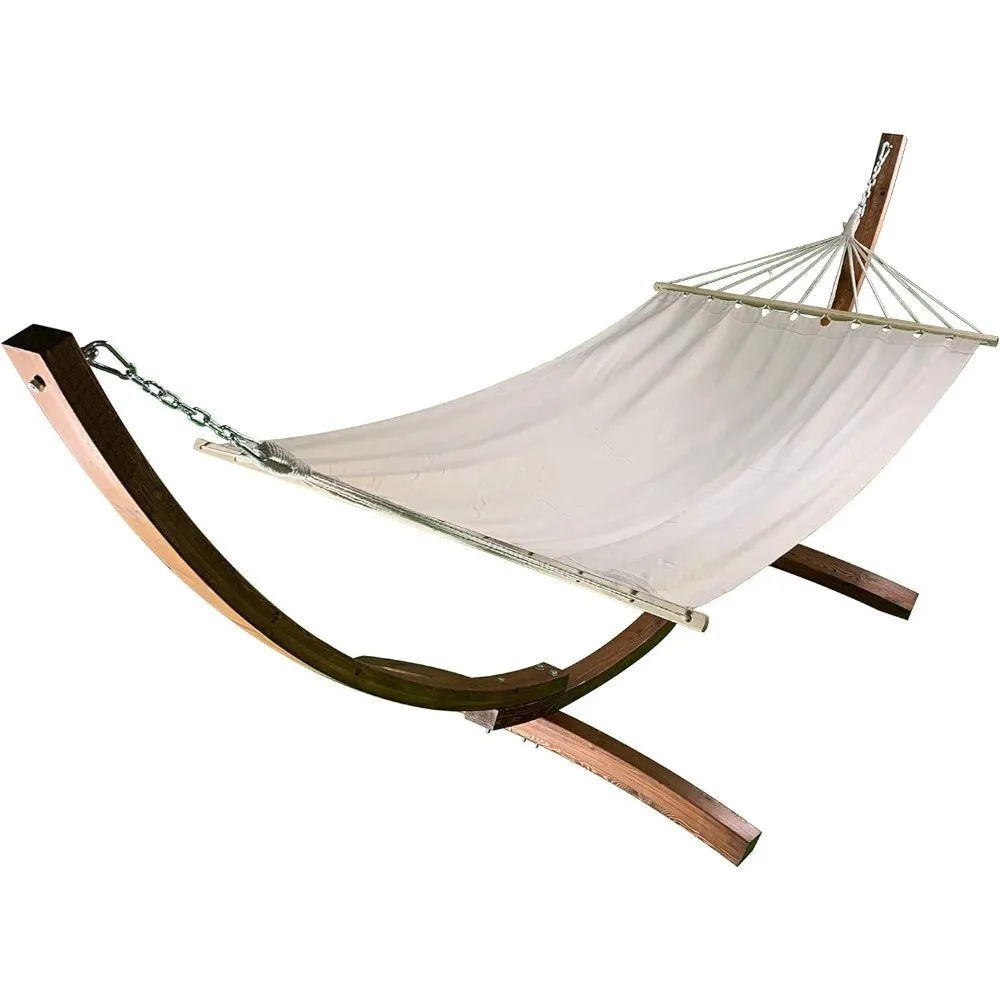
Size and Capacity: Finding Your Perfect Fit
Finding the right size hammock is essential for maximum comfort. Quilted hammocks typically come in several standard dimensions, each offering different benefits:
| Hammock Type | Typical Width | Typical Length | Weight Capacity | Best For |
|---|---|---|---|---|
| Single | 4-4.5 ft | 11-13 ft | 250-350 lbs | Individual use, smaller spaces |
| Double | 5-6 ft | 13-15 ft | 400-500 lbs | Couples, spacious individual use |
| Extra Large | 6+ ft | 15+ ft | 500+ lbs | Multiple users, luxurious lounging |
Width is particularly important for comfort – a wider hammock allows you to lie diagonally across the surface, creating a flatter lying position that many find more comfortable for extended relaxation. This diagonal position is the secret to avoiding the curved “banana” shape that can cause back discomfort in narrower hammocks.
When considering hammock dimensions, remember to account for the hanging space required. The hammock installation requirements and safety guide provides crucial information on the space needed for different hammock sizes. As a general rule, you’ll need attachment points that are 2-3 feet longer than the hammock’s total length.
Weight capacity matters not just for safety but for comfort. A hammock stressed near its weight limit will stretch more, potentially reducing the cushioned effect of the quilting. Premium quilted hammocks build in generous safety margins to ensure the materials maintain their comfort properties even with regular use at near-capacity weights.
Suspension Systems: The Foundation of a Secure Rest
The suspension system may be less visible than other features, but it fundamentally affects both safety and comfort. A well-designed suspension system distributes weight evenly, prevents excessive sagging, and ensures stability throughout your relaxation time.
Quality quilted hammocks utilize several suspension approaches:
- Chain systems: Offer excellent strength and easy adjustment with weather-resistant metal links
- Rope systems: Provide a traditional look with more flex and give during use
- Hardware connectors: Including carabiners, S-hooks, and O-rings that create secure connection points
Materials used in suspension components significantly impact durability. Marine-grade stainless steel hardware resists corrosion even in coastal environments, while zinc-plated options offer good protection at a more moderate price point.
The feel of a hammock changes dramatically based on suspension design. Systems with less stretch create a firmer, more supportive surface, while those with controlled flexibility allow for a gentle rocking motion that many find soothing. The attachment points should distribute stress across the hammock’s edge rather than concentrating it at single points, preventing premature wear.
For heavier users or those who plan to share their hammock, our heavy-duty hammock sets feature reinforced suspension systems designed to provide extra stability without compromising comfort.
Weather Resistance Features: Year-Round Enjoyment
A truly premium quilted hammock incorporates multiple features that extend its usable season and protect your investment against the elements.
UV protection represents one of the most important weather-resistance factors. Quality outdoor hammocks incorporate UV stabilizers that prevent fabric degradation from sun exposure. Look for fabrics with high UV ratings (typically measured on a scale that indicates years of color retention under normal conditions).
Water resistance technologies have advanced significantly in recent years. Modern treatments create fabrics that:
– Repel light rain and morning dew
– Dry quickly after exposure to moisture
– Resist water penetration at the quilting seams
– Prevent mildew growth in humid conditions
Temperature adaptability is another hallmark of premium quilted hammocks. The insulation provided by quality filling creates a comfortable microclimate that extends usable seasons in both directions – keeping you cooler in summer by providing a barrier against hot surfaces and warmer in spring and fall by trapping body heat.
Understanding whether it’s okay to leave your hammock outside helps you make informed decisions about placement and protection. While premium hammocks offer excellent weather resistance, proper care still extends their lifespan considerably.
Comfort Enhancements: The Little Details That Matter
Beyond the core construction, premium quilted hammocks incorporate thoughtful details that elevate the comfort experience:
Integrated Pillows and Bolsters
The addition of built-in or detachable pillows transforms comfort by providing proper head and neck support. Premium designs integrate these seamlessly into the hammock structure while allowing for adjustable positioning.
Edge Design
The hammock edge significantly impacts both entry/exit ease and overall stability. Quality designs feature:
– Reinforced edges that prevent stretching over time
– Gentle curves that eliminate uncomfortable pressure points
– Non-slip surfaces that increase security during entry and exit
Reversibility Options
Some premium quilted hammocks offer reversible designs with different patterns or colors on each side, allowing you to change the look seasonally or match different outdoor décor schemes.
Functional Additions
Thoughtful extras enhance the practical aspects of hammock enjoyment:
– Integrated storage pockets for books, devices, or beverages
– Attachment points for optional accessories like canopies or bug nets
– Quick-connect systems for faster setup and takedown
These seemingly small details often make the biggest difference in day-to-day enjoyment, transforming a simple relaxation tool into a personalized comfort zone.

Visual Appeal and Design: Style Meets Comfort
While comfort remains paramount, the aesthetic appeal of your quilted hammock significantly enhances the overall relaxation experience. Premium hammocks treat visual design as an integral part of the product rather than an afterthought.
Color options range from classic neutrals that blend with natural surroundings to vibrant patterns that create a focal point in your outdoor space. The best designs consider both immediate appeal and long-term visual satisfaction, avoiding overly trendy patterns that might feel dated quickly.
Fabric patterns in quality hammocks serve both aesthetic and functional purposes:
– Textured weaves add visual interest while concealing minor stains or wear
– Multi-colored designs mask potential fading in high-sun environments
– Coordinated color schemes allow for easy integration with existing outdoor furniture
The visual weight of the hammock – how substantial it appears in your space – should complement its surroundings. A heavy wooden stand paired with a substantial quilted hammock creates a permanent-feeling installation, while sleeker designs provide a lighter visual footprint.
Finding the perfect hammock placement for your home or garden allows you to maximize both the functional and aesthetic benefits of your quilted hammock. The right positioning transforms a simple relaxation tool into a design statement that enhances your entire outdoor living concept.
Durability and Construction Quality: Built to Last
A truly cozy quilted hammock maintains its comfort properties over years of use – making durability a comfort feature in its own right. Premium construction details directly impact longevity:
Superior Stitching Techniques
Quality hammocks feature:
– Double or triple stitching at stress points and seams
– UV-resistant thread that withstands sun exposure
– Reinforced edge stitching to prevent stretching and tearing
Hardware Durability
Metal components should incorporate:
– Rust-resistant finishes appropriate for outdoor use
– Weight ratings that exceed the hammock’s stated capacity
– Secure attachment methods that prevent slippage or failure
Edge Reinforcement
The hammock edge experiences significant stress during entry and exit. Premium designs incorporate additional fabric layers, binding tape, or reinforced seams at these high-wear areas.
Stress Distribution
Quality design distributes weight across multiple attachment points rather than concentrating stress on a few areas. This prevents premature wear and maintains the hammock’s shape over time.
The unmatched comfort of quilted hammocks comes partly from their ability to maintain their original properties over extended use. While budget options might feel comfortable initially, premium construction ensures that cozy feeling remains consistent season after season.
How to Choose Based on Your Specific Needs
Selecting the perfect quilted hammock requires aligning features with your specific usage plans and environment. Consider these key factors:
Primary Use Pattern
How will you primarily use your hammock?
– Daily relaxation requires maximum durability and comfort features
– Occasional weekend use might allow more focus on aesthetic elements
– Seasonal use demands appropriate weather resistance for that period
Environmental Considerations
Where will your hammock live?
– Full sun exposure necessitates maximum UV protection and fade resistance
– Partial shade allows more flexibility in material selection
– Indoor use shifts priorities toward softness and appearance over weather resistance
Available Space
How much room do you have for installation?
– Limited space might require a stand rather than distant anchor points
– Smaller areas may benefit from a more compact single hammock
– Spacious settings allow for larger options with more accessory potential
Personal Comfort Preferences
What feels best to you?
– Side sleepers often prefer hammocks with more give and conforming properties
– Back sleepers might favor firmer, flatter surfaces with spreader bars
– Those who change positions frequently benefit from wider hammocks
Comparing indoor versus outdoor hammocks helps clarify which features matter most for your specific situation. Remember that the best hammock is one that matches your actual usage pattern rather than an idealized vision of how you might use it.
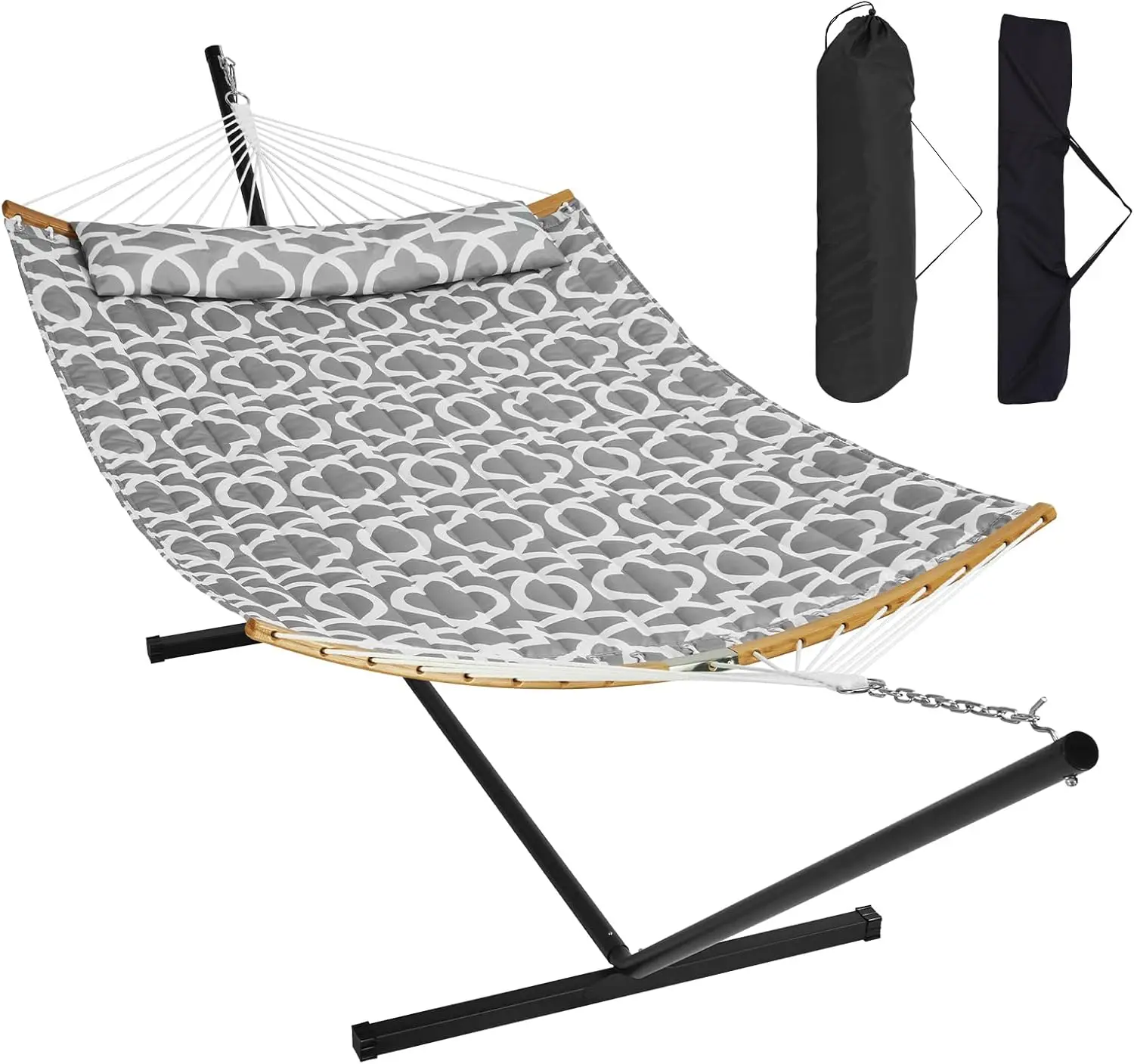
Classic Wooden Stand Hammock Sets, Heavy Duty Hammock Sets
$1,061.68 Select options This product has multiple variants. The options may be chosen on the product pageHammock Sets with Canopy, Heavy Duty Hammock Sets
$286.31 Select options This product has multiple variants. The options may be chosen on the product pageDouble / Two Person Hammock Sets, Rope Hammock Sets
Double Traditional Cotton Rope Hammock with Extension Chains – 450 lbs Capacity for Backyard & Patio$292.98 Select options This product has multiple variants. The options may be chosen on the product pageHeavy Duty Hammock Sets, Wooden Arc Stand Hammock Sets
$878.66 Select options This product has multiple variants. The options may be chosen on the product page
Is a Stand Necessary for Quilted Hammocks?
A dedicated hammock stand isn’t strictly necessary but offers significant advantages for many quilted hammock owners:
Benefits of Dedicated Stands
– Creates a complete, self-contained relaxation system without needing trees or structural attachment points
– Ensures proper hanging height and angle for optimal comfort
– Eliminates potential damage to trees or building structures
– Allows for repositioning to follow shade or views
– Provides correct weight support specifically designed for hammock use
Space Considerations
Quality stands require:
– Approximately 2 feet more length than the hammock itself
– Width appropriate to the hammock type (wider for spreader bar styles)
– Stable, level ground for safe setup
Material Options
Hammock stands come in several materials, each with distinct advantages:
– Steel frames offer maximum stability and weight capacity
– Wooden stands provide aesthetic appeal that complements outdoor spaces
– Aluminum options offer lighter weight for occasional repositioning
For quilted hammocks specifically, stands should provide sufficient weight capacity to support both the heavier construction of quilted designs and their intended users. Our double two-person hammock sets include stands specifically rated for the additional demands of multi-person use.
Are Quilted Hammocks Suitable for Year-Round Use?
Quilted hammocks excel in extending the comfortable hammock season beyond summer months. Their padded construction provides insulation that makes spring and fall hammocking enjoyable, while the substantial fabric offers protection from hot surfaces during peak summer.
For true year-round use, consider these factors:
– Quilted hammocks with weather-resistant fabrics can withstand seasonal elements but should be stored during extreme weather
– Indoor use during winter months provides a cozy retreat when outdoor use isn’t practical
– Quick-dry features become essential for regions with frequent rain or heavy morning dew
– UV protection remains important even in cooler seasons to preserve fabric integrity
The key to maximizing year-round enjoyment is creating the right environment. Creating a perfect hammock haven might include adding nearby shelter, considering sun patterns throughout the year, and selecting accessories like weather covers that extend usable seasons.
How Do I Care for a Quilted Hammock?
Proper maintenance ensures your quilted hammock remains cozy for years to come:
Regular Cleaning
– Brush off loose debris regularly to prevent staining
– Spot clean spills immediately with mild soap and water
– Follow manufacturer guidelines for deeper cleaning—typically using gentle detergent and soft brushes
– Allow complete drying before storage to prevent mildew growth
Storage Recommendations
– Store in a dry, ventilated space when not in use for extended periods
– Fold loosely rather than tightly rolling to prevent permanent creases
– Use a breathable storage bag rather than plastic containers
– Ensure complete dryness before long-term storage
Preventative Care
– Inspect hardware and attachment points monthly during heavy use seasons
– Apply fabric protectant appropriate for your hammock material (if recommended)
– Rotate the hammock occasionally to distribute wear evenly
– Remove tree debris, sap, or bird droppings promptly to prevent staining
With proper care, a premium quilted hammock can provide a decade or more of cozy relaxation experiences, making it not just a purchase but an investment in your outdoor lifestyle.

